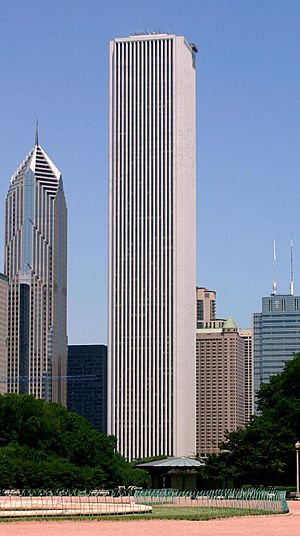Economy of Illinois facts for kids

Chicago, the largest city in Illinois
|
|
| Statistics | |
|---|---|
| GDP | $1.137 trillion (2024) |
|
GDP per capita
|
$89,475 (2024) |
| 0.469 | |
|
Labor force
|
6,483,999 (August 2023) |
| Unemployment | 4.8% (Feb. 2025) |
| Public finances | |
| Revenues | $29.762 billion |
| Expenses | $19.831 billion |
The economy of Illinois is one of the biggest and most varied in the United States. It ranks as the fifth largest by its total economic output, known as GDP. A huge part of this economy comes from the Chicago area. Many of the largest companies in the U.S. have their main offices there.
Some of these big companies include Abbott Laboratories, McDonald's, United Airlines, and Walgreens. Chicago is also a major global center for finance. It is home to important financial groups like Citadel LLC and the Chicago Mercantile Exchange, which is the world's largest place for trading futures.
Other large companies in Illinois are State Farm in Bloomington and John Deere in Moline. Illinois is a top state for having many of the biggest companies in the country. For six years in a row, the Chicago area was the best place for companies to move or expand their businesses.
In 2024, Illinois's total economic output was about $1.132 trillion. This makes it the fifth highest in the nation. The average household income in 2021 was $72,205, which is one of the highest in the U.S. The state makes many things, like machinery, food products, and electrical equipment. Important farm products include corn and soybeans. Key service industries are finance, education, shipping, and healthcare.
Contents
Farming in Illinois
Most of Illinois is part of the North American Corn Belt. This means farmers grow a lot of corn, soybeans, and other large field crops. These crops and the products made from them are a big part of Illinois's economy outside of Chicago. Much of the corn and soybeans are used to feed hogs and cattle.
Dairy products and wheat are also important crops in some parts of the state. Illinois farmers also grow special crops like popcorn and pumpkins. Illinois is actually the biggest producer of pumpkins among all U.S. states! There's also a large area for growing watermelons near Lincoln, Illinois. Illinois wine is also a growing industry.
Making Things: Manufacturing
Manufacturing in Illinois creates about $101 billion in economic activity. This makes up 14% of the state's total output. Illinois's manufacturing sector grew from its strong farming background. For many years, the Union Stock Yards in Chicago were very important. From 1865 to 1971, millions of cattle and hogs were processed there into meat.
In the past, there were laws to protect workers. In 1893, a law was passed to stop child labor and set an eight-hour workday. This helped make sure children were safe and not overworked.
Because Illinois is located in the middle of the country, it became a key place for manufacturing. This was especially true for farm machinery and special motor vehicles. Cities like Aurora, Peoria, Decatur, and Rockford became major manufacturing centers. The John Deere Company, located in downstate Illinois, became one of the world's largest makers of farm machinery. Caterpillar also became very big in making off-road vehicles.
The Chicago area also started making a lot of telecommunications equipment, electronics, steel, cars, and other industrial products. By 2004, the top manufacturing industries in Illinois included chemical products, food products, machinery, and metal products.
Clean Energy: Renewable Power
Illinois is a leader in clean energy. It ranks second in the Midwest for how much renewable power it has installed. It's also fifth nationally for wind power. The renewable energy industry has created 114,000 jobs in Illinois. This industry is expected to grow even more. This is thanks to a $15 billion investment from the Future Energy Jobs Act in 2016.
In 2019, Governor J. B. Pritzker joined Illinois with the U.S. Climate Alliance. This group works to fight climate change. This commitment will help the renewable energy economy grow even more across the state.
Important Services
By the early 2000s, Illinois's economy started to rely more on high-value services. These include financial trading, higher education, logistics (moving goods), and medicine. These services often grew around institutions that were already important in Illinois's history.
In the late 2010s, the Chicago Metropolitan Area continued to be a top choice for companies. Many businesses chose to move their offices or expand their facilities there.
Tourism in Illinois
Tourism is a big part of Illinois's economy. In 2018, Illinois had a record number of visitors, with 117 million tourists. This was 3 million more than the year before. These visitors spent almost $42 billion in the state during that same year.
See also
- Economy of Chicago
- Great Lakes Megalopolis


